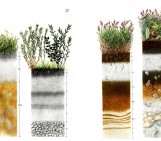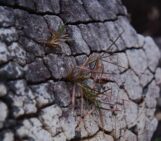Many artists draw inspiration from nature and it’s not surprising when faced with landscapes which are as beautiful as the one featured in this week’s Imaggeo on Mondays post. Josep Miquel Ubalde Bauló writes about the origin of the colourful mud pots and bobby-socks trees!

Artists’ Paintpots in Yellowstone National Park. Credit: Josep Miquel Ubalde Bauló (distributed via imaggeo.egu.eu)
This picture corresponds to The Artist Paint Pots, found in in Yellowstone, the first National Park of the world. Yellowstone is one of the most geologically dynamic areas on Earth. A huge underlying magma body releases enormous amounts of heat , which feed more than 10000 hydrothermal features (geysers, hot springs, mudpots, fumaroles), approximately half of all those found in the world.
The Artist Paint Pots is a small geothermal area, which was named after the pastel multicoloured mud pots. Much of the water in these mud pots is near boiling (85 ºC), meaning it is is difficult for life to thrive in them . Only some cyanobacteria and algae can live under these extreme conditions, and they are responsible for the beautiful colours in the mud pots.
The mud pots are acidic thermal features with a limited water supply. For their formation they require sulphite-reducing bacteria, which use hydrogen sulphide for energy, giving sulphuric acid as a waste product. The acidic water slowly dissolves the surrounding rocks, forming fine particles of silica and clay. This viscous clay-water mixture creates a muddy area, with the hot mud boiling and gas bubbling at the surface. The paint pots are coloured mud pots, which range from pink to bright red to purple, due to the iron oxides, potassium, and magnesium in the soil. The reason for the colours in the mud pots is a lack of sulphur. When sulphur is present, it reacts with iron oxides forming pyrite, which is grey.
In this area you can observe some groups of standing-dead trees. Whilst some of them burned in the fires of 1988 (during an unusually dry summer), others have been killed by the runoff from nearby thermal features, which flooded the area around the trees. Minerals in the water plugged the base of the trees and killed them, leaving their bases white. Those trees are known as bobby-socks trees.
By Josep Miquel Ubalde Bauló, Soil Scientist, Miguel Torres Winery
If you pre-register for the 2015 General Assembly (Vienna, 12 – 17 April), you can take part in our annual photo competition! From 1 February up until 1 March, every participant pre-registered for the General Assembly can submit up three original photos and one moving image related to the Earth, planetary, and space sciences in competition for free registration to next year’s General Assembly! These can include fantastic field photos, a stunning shot of your favourite thin section, what you’ve captured out on holiday or under the electron microscope – if it’s geoscientific, it fits the bill. Find out more about how to take part at http://imaggeo.egu.eu/photo-contest/information/.


